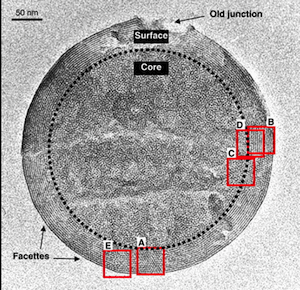Ask for a reprint
email :
* Give your email
2007
ACL
|
B.Alonso, E.Véron, D.Durand, D.Massiot, C.Clinard, 'New insights in the formation of mesoporous materials through spray-drying', Microporous Mesoporous Mat. 106 76-94 (2007) doi:10.1016/j.micromeso.2007.02.028
New insights into the formation of textures result from a detailed characterisation of spray-dried mesoporous silica-based microspheres by Nuclear Magnetic Resonance (NMR), Small Angle X-Ray Scattering (SAXS), Transmission Electron Microscopy (TEM), and Scanning Electron Microscopy (SEM). Representative samples are obtained from sols of different chemical composition and containing surfactant molecules (cetyltrimethylammonium bromide, CTAB) and siloxane oligomers. The study of the morphological and textural properties leads us to complete the previous knowledge on these materials. We have shown that there is always a phase separation between the surfactant aggregates and the siloxane network at the nanometric level, but not at a microscopic or macroscopic level. In addition, the characteristics of the small interacting colloids (CTAB micelles and siloxane oligomers) determine the morphology of the samples, the proportions of non-ordered and ordered domains, as well as the spatial extent and the nature of the ordered phases. Two kinds of constrains exist at this respect: the rate of solidification during spray-drying, and the steric constrains imposed by the geometry of the ordered phases. From our results, we propose a mechanism of texture formation during spray-drying through two main steps: the evolution from an isotropic liquid to a non-ordered phase made of micelles and siloxane oligomers; and the transition from this non-ordered phase to an ordered phase by the spatial reorganisation of the micelles and their concomitant fusion into elongated rods.
|

|